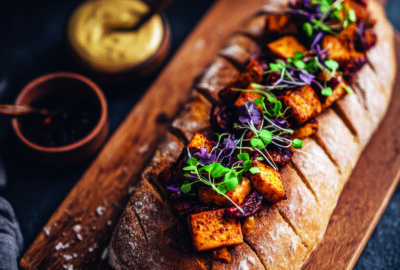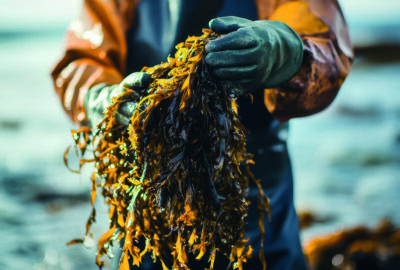The latest figures from WRAP show that a total of 3,415,000 tonnes of waste is disposed of in the food sector every year, and 600,000 tonnes of the waste from pubs, restaurants, hotels and fast food outlets is food waste. Nearly one million tonnes of this is edible food.
In an industry first, the Sustainable Restaurant Association has launched ‘Food Waste; Bad Taste’ online programme, urging hospitality businesses across the country to target, measure and act on food waste in their business. The online programme provides a collection of materials, tips and guidance to help businesses reduce their carbon footprint, save money and contribute to the UN’s Sustainable Development Goal 12.3 – cutting global food waste by 50% by 2030.
Here several industry-leading chefs share their thoughts on how to reduce food waste…
Jeremy Pang founder of the School of Wok, London www. schoolofwok.co.uk
Look in your pantry and use up what’s inside! Dried ingredients such as noodles, rice, mushrooms, sauces and spices can help carry a meal and finish up leftovers in the fridge. Never throw veggies away, slice them up thinly and use them up in stir-fries or curries; just a simple handful of beansprouts or an end of a spring onion can easily be pieced together with some soaked noodles and some dark soy sauce to make up a full meal! We always do a curry, something we can wrap like a dumpling, and a stir-fried noodle to finish it off, as all these are massively versatile and no matter what you throw into them, they will taste good!
Samantha Williams head chef at Angela Hartnett’s Café Murano in London
We’re part of 11 restaurants who have signed up with The Regent Street & St James’s Food Waste Pledge, which aims to reduce food waste in the area by 25% by May 2020. We’re working closely with the Sustainable Restaurant Association where we will continually monitor our food waste production to ensure a marked decrease. We‘ve seen significant improvements, especially through working with our suppliers to purchase more sensibly to reduce our footprint. This is reflected in our recipes; bread that is left over from the day before we turn into breadcrumbs to panné our signature chicken milanese and grill it to
use in our ribollita. We also use our Parmesan rinds in our arancini and as a base for soups. Pasta offcuts are used for Malfatti pasta shapes, the Italian sausage ragu now has its flavour enriched by the addition of the trimmings from salami and prosciutto as well as the ends from the fennel, for an extra hit of aniseed. Courgette hearts from the fritti are also saved and used in a delicious creamy pasta sauce for staff food. It’s really got us thinking about how we help reduce our waste and be inventive with our menus.
Andres Rivera sous chef at Farmacy, has completed the ‘Food Waste, Bad Taste’ programme (https://thesra.org/campaign/foodwaste/)
Every time we look at creating a new dish now we think about it as a whole. We had a cauliflower dish on the menu recently, but we couldn’t find a good use for the leaves, so we switched to broccoli instead and we use the stalks in a salsa.
Think about all the different ways you can use every part of the ingredient from root to leaf – you can serve different bits in maybe four or five dishes. We’ve found that has helped us cut our overall waste and reduced the total number of dishes on the menu. Another great way to reduce prep waste is to pass on to the bar the fruit and vegetables that you can’t use in the kitchen. We’ve found that the best way to cut down on plate waste is for our front of house team to talk to customers both at the beginning of the meal when they can make sensible suggestions about how much to order and at the end, offering a doggy bag. About 70% of people we offer one to end up taking home their leftovers.
Stephen Forster national chair of LACA
LACA’s members sit at the heart of the school food industry. We have pledged to become part of the growing movement to reduce food waste through the Guardians of Grub campaign (http://www.wrap.org.uk/ content/guardians-grub) As the new national chair, I am encouraging all of our members to save food, monitor the amount of food that is eaten and track the amount of waste that goes in the bin. Make sure that you get your menus right and fresh cook as much as possible. With rising food and transportation prices reducing waste is not only good for the environment, but also saves money.
Mark Simpson head of operations, The Felix Project
We rescue food from going to waste and get it to charities for people in London who struggle to afford good food, and to primary schools to distribute to children and their families. The suppliers
we work with are happy to give us their surplus food for free. We always have a high proportion of fresh fruit and veg, but we don’t know what’s coming! The charities we deliver to base their menus on what gets delivered, getting creative with tasty food that’s in season. It’s November, so pumpkin soup and pumpkin pie will be featuring!
Nick Anderson head chef at the Boxing Hare, Chipping Norton www.theboxinghare.co.uk
Careful menu planning is essential to minimise waste. Think of ingredients which will provide more than one dish. For example buy whole ducks, confit legs, roast breast, rillettes from the neck and trim, stock from the carcass, duck scratchings from excess skin, parfait from the livers, confit heart and gizzards for a salad. Control of ordering is another great way to control wastage, ordering a little and often avoids foods sitting
around and spoiling and assures the best quality. Watch the seasons and don’t get into the habit of continuing with expensive imports when domestic seasons end.
Arron Potter head chef at La Goccia, Petersham Nurseries, Covent Garden
At La Goccia, we are very conscious to not over-process our food – dishes are cooked to order and off cuts are turned into simple, yet tasty staff lunches. We work closely with Haye Farm in Devon, run by the son of the Petersham Nurseries owners. Our menu changes according to what’s best on the farm that day, with surplus ingredients taken and incorporated into a variety of La Goccia dishes. We also buy meat from Haye Farm and take pleasure in using the whole animal, including offal and liver.
Douglas McMaster chef founder of Silo, the UK’s first zero-waste restaurant silolondon.com
At Silo, our restaurant furniture and fittings are created using materials that would otherwise have been wasted, our plates are formed from plastic bags, tables made from mycelium, light fittings from crushed wine bottles, our bar front is made from a combination of yoghurt pots and end of life leather. All of our food waste becomes compost and all food is delivered in endlessly reusable vessels.
Marcus Wareing acclaimed chef and MasterChef the Professionals judge
Controlling waste has always been a key part of any kitchen that I have run. If you control waste in the kitchen, not only do you help the environment, but you also reduce your own costs in the kitchen. Controlling waste is as important as controlling purchasing. Have a daily special on the menu that changes and allows you to utilise some of the ingredients in the fridge that need using.
Monitor the plates, what is coming back. Are the portion sizes too big?
• Use clear bin bags. We have had them for years, it allows the head chef to see what has been thrown away and then educate if necessary.
• Can you make a dessert using old bread that wasn’t used?
Use leftover ingredients for staff lunches. Don’t set a menu for staff, use what you have
• Use the freezer – prolong the life of things by freezing them.
• Have a smaller menu and change it seasonally. You need less ingredients.
Older fruit can be cooked, make a jam or chutney
• Before buying anything check every fridge (teach the team to do the same).
• Have a line on your menu that allows you to adapt the garnish. We may use ingredients available to us.



